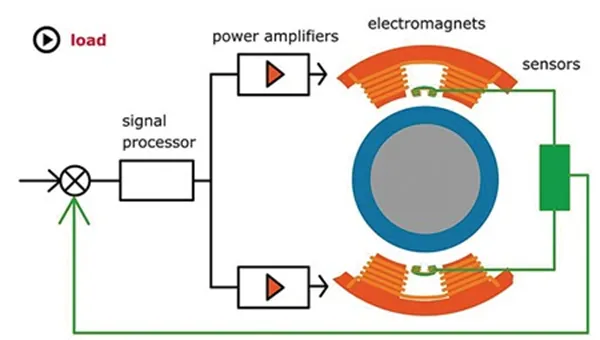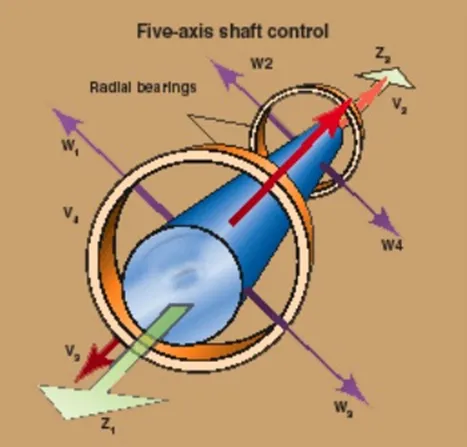Magnetic Bearing Technology

Magnetic bearings have been utilized by a variety of industries for over a decade with benefits that include non-contact rotor support, no lubrication and no friction.
Conventional mechanical bearings, the kind that physically interface with the shaft and require some form of lubrication, can be replaced by a technology that suspends a rotor in a magnetic field, which eliminates friction losses.

There are two types of magnetic bearing technologies in use today – passive and active. Passive bearings are similar to mechanical bearings in that no active control is necessary for operation. In active systems, non-contact position sensors continually monitor shaft position and feed this information to a control system. This in turn, based on the response commanded by the system, flows to the actuator via current amplifiers. These currents are converted to magnetic forces by the actuator and act on the rotor to adjust position and provide damping.
Additional benefits of magnetic bearings include:
● No friction
● No lubrication
● No oil contamination
● Low energy consumption
● Capacity to operate within a wide temperature range
● No need for pumps, seals, filters, piping, coolers or tanks
● Environmentally friendly workplace
● Impressive cost savings
In practice, these attractions are balanced in order to maintain a gap between the shaft (rotor) and static parts (stator). The function of the magnetic bearing is to locate the shaft’s rotation axis in the center, reacting to any load variation (external disturbance forces),

Floating rotors could boost compressor efficiencies
Traditional centrifugal compressors are based on low-speed drives, mechanical gears and oil-film bearings, resulting in high running costs because of their high losses, wear, and need for maintenance.
This new compressor drive (above) uses a permanent magnet motor, operating at an efficiency of around 97%, to drive a rotor "floating" on magnetic bearings, which spins the compressor impeller at speeds of around 60,000 rpm. These drives experience almost no friction or wear, and need little maintenance. They also minimize the risk of oil contamination, and result in compressors that are about half the size of traditional designs.
How they work

Magnetic bearings are basically a system of bearings which provide non-contact operation, virtually eliminating friction from rotating mechanical systems. Magnetic bearing systems have several components. The mechanical components consist of the electromagnets, position sensors and the rotor. The electronics consist of a set of power amplifiers that supply current to electromagnets. A controller works with the position sensors which provide feedback to control the position of the rotor within the gap.

The position sensor registers a change in position of the shaft (rotor). This change in position is communicated back to the processor where the signal is processed and the controller decides what the necessary response should be, then initiates a response to the amplifier. This response should then increase the magnetic force in the corresponding electromagnet in order to bring the shaft back to center. In a typical system, the radial clearance can range from 0.5 to 1 mm.
This process repeats itself over and over again. For most applications, the sample rate is 10,000 times per second, or 10 kHz. The sample rate is high because the loop is inherently unstable. As the rotor gets closer to the magnet, the force increases. The system needs to continuously adjust the magnetic strength coming from the electromagnets in order to hold the rotor in the desired position.